
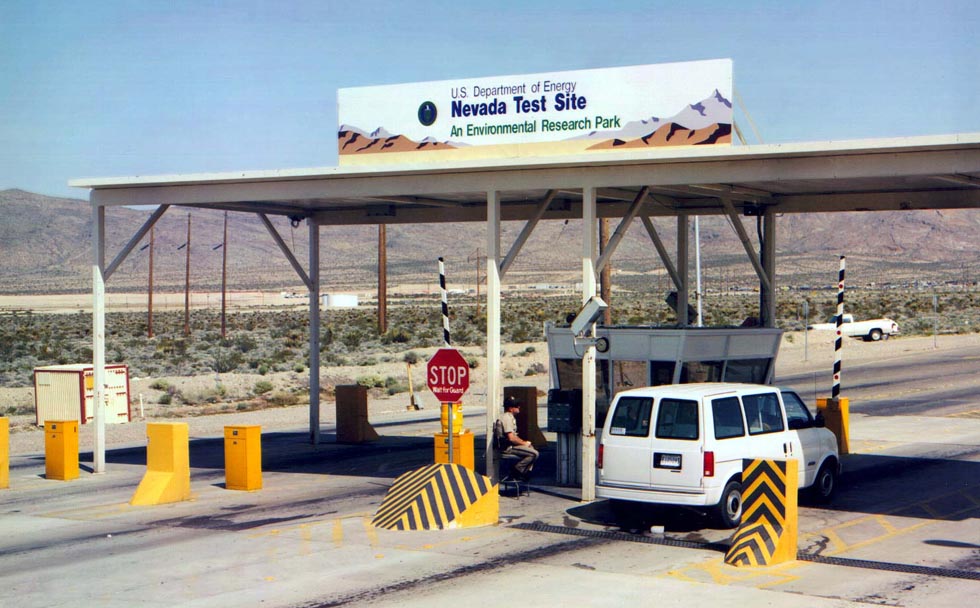
You may not know it; but you have probably seen the Nevada Test Site, and not known what it was. A large number of science fiction and horror moves will often show a nuclear explosion. Often this explosion will occur in the desert, generally with cacti in the foreground. This is the Frenchman's Flats area of the Nevada Test Site, where a number of above ground tests were made, in the fifties, and early sixties. The 1350 square mile government reservation is 65 miles from Las Vegas, and initially, casino owners worried that the tests would scare off customers. They were wrong, having underestimated the tourist tendencies of gamblers, and the gambling tendencies of tourists. Both types of characters were fascinated by the idea of seeing a nuclear bomb go off. The tests actually drew more people, who would sit on rooftops, in hopes of seeing a bright flash, or a mushroom cloud. The first tests were kept secret; but schedules of atomic tests were eventually published, so that early nuclear tourists could go up to rooftops, or out on balconies to watch. Those with a sense of adventure, might drive out into the desert, to get a bit closer. All together, in 928 tests, there were 980 (some say as many as 1021) nuclear explosions set off here, out of which around one hundred were atmospheric tests, which is to say they were set off above ground. The rest were underground tests, producing large subsidence craters.
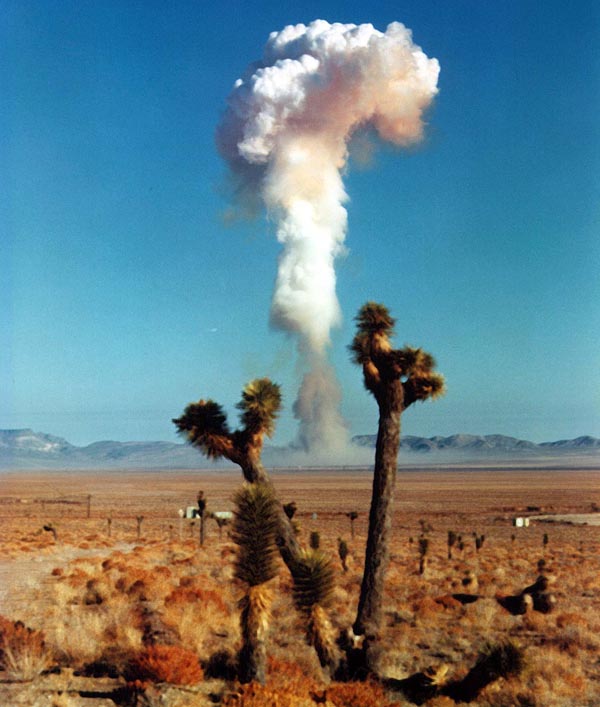 Unfortunately, I have no photos of my tour of the site.
The photos here are taken from the web. It is illegal
to photograph this area, because there is a federal law forbidding the photographing,
or sketching of any government reservation, which is considered vital to
the national defense. This law generally makes good sense, as you would not
like to think that muslim terrorists or other sub-humans could easily get plans
to airbases, nuclear facilities, or other vital installations, which might be
helpful in attack or sabotage. On the other hand, The Nevada Test Site is where
we have, for decades, set off nuclear explosions. I have to wonder what
officials think that terrorists might do to the place. Are they afraid that they
might blow it up?
Unfortunately, I have no photos of my tour of the site.
The photos here are taken from the web. It is illegal
to photograph this area, because there is a federal law forbidding the photographing,
or sketching of any government reservation, which is considered vital to
the national defense. This law generally makes good sense, as you would not
like to think that muslim terrorists or other sub-humans could easily get plans
to airbases, nuclear facilities, or other vital installations, which might be
helpful in attack or sabotage. On the other hand, The Nevada Test Site is where
we have, for decades, set off nuclear explosions. I have to wonder what
officials think that terrorists might do to the place. Are they afraid that they
might blow it up? What I have done instead is to take photographs of the outlying areas, just outside of the range itself. There is nothing illegal about this, and the nearby areas outside of the range are pretty much indistinguishable from those inside, except for the lack of craters in certain sections. Still, it is close enough, to give some idea of what the area is like. Most nuclear testing is now done through computer simulations, at least in the United States.
This is technically now a DOE site, rather than a military site; but the gates, guard posts, and heavy security leave little doubt that the military still has a keen interest in the place. Of the over 12,000 workers who had once staffed the area, only about 1800 remain. Still, an institution employing 1800 people is hardly what you would call a small facility.
During the fifties, solders were trained here, in how to operate in a nuclear environment. This was not Civil Defense training, but was military training. It was also not only acclimatization; but actually sought to train men to make use, or to be made use of, on the new nuclear battlefield. Soldiers were to learn how to attack, advance, and attain objectives, under cover of tactical nuclear weapons.
I suppose that you never know what information might be helpful to the various savages in the world, so perhaps the photography ban is not as unreasonable as it might seem. In order to moderate things a bit, and in recognition of the fact that people are nosy, but usually mean no harm, the DOE has made photographs available for public distribution on it’s web site. I have included a few of these photos here, with appropriate credits. It rankles my vanity a bit to use someone else’s photos on my site; but the only alternative was to have no photos at all, of the craters and landmarks within the range.
The Nevada Test Site is located within the Nellis test range, a navy test range, and is also adjacent to the most famous top secret site in the world - Area 51
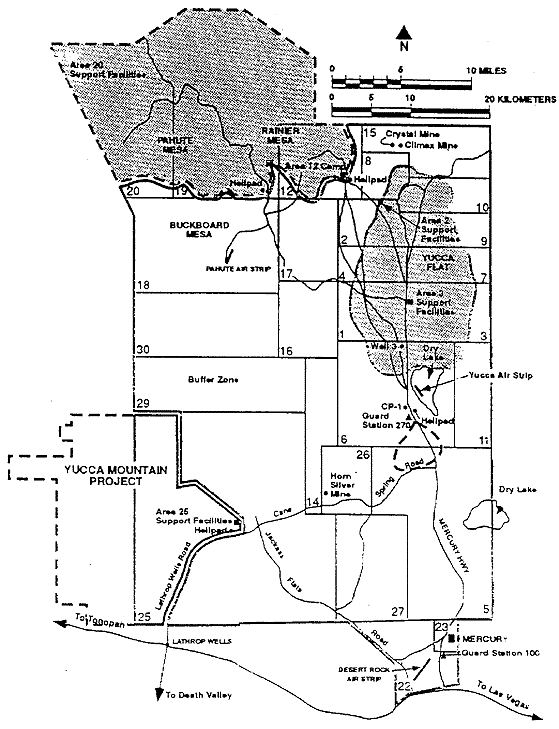 (Groom lake). It was one of three or four sites being considered, in the
early fifties, for nuclear testing. Previous nuclear tests had been performed on
captured South Pacific islands, which had formerly been Japanese possessions.
Like the Trinity site, at White Sands, the place was decided upon largely
because of its desolation.
(Groom lake). It was one of three or four sites being considered, in the
early fifties, for nuclear testing. Previous nuclear tests had been performed on
captured South Pacific islands, which had formerly been Japanese possessions.
Like the Trinity site, at White Sands, the place was decided upon largely
because of its desolation.
Everybody knows what goes on at the Nevada Test site, right? They set off
nuclear bombs. Well, not since 1992, when President Bush enacted a temporary
moratorium on nuclear testing, which
There is actually quite a bit going on here, and the place is being used as a sort of an open lab, for a number of different lines of inquiry. The site is large, isolated, and in addition to being quite a distance form any population centers, there is a very low water table, and little rain fall. This combination of factors means that things can be done here, that might be a bit dangerous, or might be easily disturbed by changes in weather. So there is a bit more to the site than simply being a place where you can blow things up, or store nuclear waste, because everyone is too far away to care. I will be writing here, more than usual, because I have no photos to display. Photography is not allowed here, or at any rate is allowed only with very special permission. As a picture is worth a thousand words, and I have no pictures of my own, many thousands of words will be required to describe the tour. I have included a rough map, taken from the DOE web page for the Nevada Test Site, to the right. It shows most of the more important areas, and gives a good general idea of the layout of the site. The surrounding Nellis Bombing Range, as well as the nearby desert, keeps the place quite isolated, from the outside area. The California border is nearby, along with Death Valley Monument.
A Public Tour
Taking a tour of this place is
easier than you might think, though it does take a bit of planning. We met at the
The first step is to badge in. At least six weeks before the tour, visitors are required to fill out a form so that backgrounds, and identities may be checked. Upon successful completion of the background check, the applicant receives a phone call, advising that they have a spot on the tour, and reaffirming the tour date and time. About ten days before the tour date, a package is sent, with tour materials. At the site, we are all asked for photo ID, and are checked off against a list. We then board the bus (there were two for this group), and head out for the hour-long drive to the NTS at Mercury.
The drive out was kind of interesting in it's own right. You pass through parts of the downtown area, and then out of the city and into the desert. A few miles outside of the city, there is nearly nothing, other than the road itself, to indicate the presence of humanity. There are few cars, and fewer structures. Occasionally, a tail of dust will indicate the presence of a vehicle, somewhere off the road. The landscape was not the sandy desert of old movies; but was filled with Joshua trees, mountains, and sparse scrub. Our first stop will be Mercury.
Mercury is kind of what you would expect of a government base for transients. It is part trailer park, part military base, part warehouse, and part motel 6. This is where we got out water coolers, for the trip. The desert is no joke, and this area is desert. Though the tour materials said there would be no food, there is a cafeteria there, and it was open when we arrived. The cafeteria had coffee, soft drinks, snacks, and some light lunch style fare. There was no hot food. There were also vending machines, which were stocked. Still, there were something like 60 of us on the tour, and there would not have been enough in the machines for all of us. So it would probably be good to have a lunch. There is a convenience store, and a Jack in the Box, right across the street from the museum, back in Las Vegas. This is where I got my lunch.
Mercury is the headquarters for
the site, though it is an administrative and support area only. The shots are
set off at another location. The place is full of pads for trailers, as well as
steel utility buildings. There are some permanent structures; but the whole
facility has the feel of a place that is not certain how long it will be
staying. Few people are allowed to live at the NTS, and most workers here, live in
Mercury has not always been this way. Back before the test ban, in 1992, something like 10,000 people lived here. It was a pretty lively place, with places to eat, entertainment, quite a bit more housing than it now has, and even such facilities as a bowling alley, public pool, and movie theater. Most of this is gone now, and only a few hundred of the remaining 1800 people who work the site live here. Even many of the building that are still being used, are often closed, as they do not require constant staffing. This place is, if not a ghost town, a shadow of what it had once been.
Just outside Mercury, is the gate.
A frighteningly young, but very serious and sober young soldier boards the bus,
and looks us all over, making certain that we all have badges – he is the gate
guard. The badges were issued to us, after having had background checks, and the
verification of our identities. These badges thus advise the guard that we have
been checked and cleared. Badges must be worn, and must show at all times. If
the guard does not see a badge, he will ask for it’s display, as he had to do
with one of the passengers who had removed her jacket. It is not his job to
clear us, verify our identities, or check our backgrounds. He has neither the
training, nor the resources to do so, which is why we were issued the badges. If
you do not have a badge, the guard can only assume that you do not belong here -
you do not get inside. The badges all must be returned upon leaving.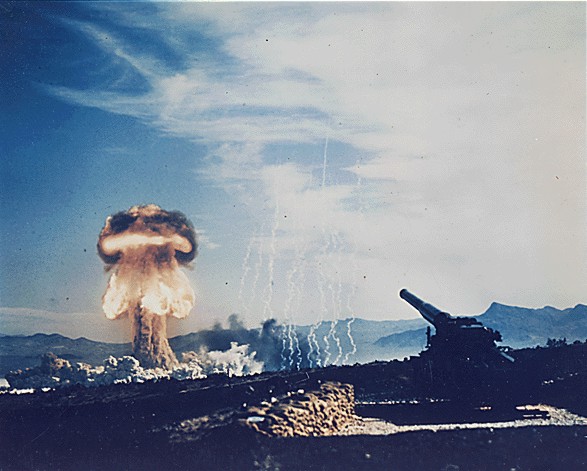
Frenchman’s Flat is the first area of any interest, through which we pass. This is where the above ground tests took place, mostly, and where the houses, and other such things that you see being knocked down in the nuclear test films, were built. It is, as the name implies, a large, flat, open area, which is essentially a dried up lake bed. Nuclear devices were dropped by plane, set off in towers, and exploded from balloons, over this area. We will be returning to this area, before we leave. For now, we just drive through, and have some of the more interesting features pointed out to us. In total, nineteen tests (14 surface and five underground) occurred at Frenchman's Flat.
On the way out, we passed some sets of trenches, where soldiers had once crouched, during the Grable test. This was, as far as I know, the only firing of a nuclear artillery piece. This was a 280 mm cannon, for which a 15kt nuclear shell had been designed. The cannon was able to lob this shell seven miles, to explode 524 feet above the ground (who measures these things?). The soldiers involved in the test, had been assured by scientists, that there was no danger, as long as they stayed down in the trenches, and did not attempt to rise up and see the explosion. These scientists had calculated that the depth of ground cover, at the angle of the explosion would give sufficient protection. Of course, none of these scientists could reassure the troops personally, since they were all miles away, and none were actually present in the trenches themselves. The trenches in question were dug by bulldozers, sparing the troops the effort of digging their own holes. The atomic canons were never actually used in war, and were eventually replaced by tactical nuclear missiles.
 Not too far from Frenchman’s Flat
is the Low level nuclear waste facility. This is a burial site, and is not the
place where they store old fuel rods. Actually, hazardous waste of many types is
kept here, and there is a fair amount of buried asbestos at the site, or rather,
under it. Waste is buried in what are called cells. Each cell is a 120 x 65 feet
rectangle, by 25 feet deep. Waste is brought in my truck, in sealed containers.
When a cell is full, it is “closed”, which is to say, the whole thing is covered
over by dirt. Closed cells are marked at their boundaries by white concrete
obelisks, which appear a bit like old fashioned road markers, or perhaps
miniature headstones. When the entire facility is full, another four feet of
earth will be piled on top of all of the closed cells. This will give 12 feet of
coverage. The proper cover depth was determined by considering the most active
member of the local ecology, which happens to be the local ants. These ants dig
down to a depth of 11 feet, which would make the 12 feet of coverage seem
adequate. We stop for a few moments, and are given a talk, and brief description
of the mission of the facility, by one of the people who work there.
Not too far from Frenchman’s Flat
is the Low level nuclear waste facility. This is a burial site, and is not the
place where they store old fuel rods. Actually, hazardous waste of many types is
kept here, and there is a fair amount of buried asbestos at the site, or rather,
under it. Waste is buried in what are called cells. Each cell is a 120 x 65 feet
rectangle, by 25 feet deep. Waste is brought in my truck, in sealed containers.
When a cell is full, it is “closed”, which is to say, the whole thing is covered
over by dirt. Closed cells are marked at their boundaries by white concrete
obelisks, which appear a bit like old fashioned road markers, or perhaps
miniature headstones. When the entire facility is full, another four feet of
earth will be piled on top of all of the closed cells. This will give 12 feet of
coverage. The proper cover depth was determined by considering the most active
member of the local ecology, which happens to be the local ants. These ants dig
down to a depth of 11 feet, which would make the 12 feet of coverage seem
adequate. We stop for a few moments, and are given a talk, and brief description
of the mission of the facility, by one of the people who work there.
The site will only take low lever waste, which is to say, waste that is other than disposed of fuel rods. The expended rods are buried at Yucca mountain, at a separate site. Still, some of the so called low level waste is pretty radioactive, and even included parts from dismantled nuclear reactors. High level and low level wastes are differentiated by their sources. Thus all expended fuel rods are considered high level waste, while everything else is considered low level waste, even if it is sometimes at or above the radiation levels of spent fuel rods. Though this might seem a bit odd, there is a reason for this. It is not the level of radiation, but the level of proliferation danger, that determines the type of waste. Spent fuel rods may be reprocessed, by well developed techniques, into nuclear explosives or fuel. Most other nuclear wastes are far too impure and dilute to lend themselves to this process.
We are not allowed off of the bus,
and before we leave, several personnel linger near the sides, and particularly
the wheels, checking to make sure that we didn't pick up any contamination from
the site. We are assured that this is unlikely; but they check anyway, just to
be on the safe side. As we listen, and look the site over, we see a number of
trucks coming in, with new loads of waste. These are all in sealed containers,
and are driven down long sloping ramps into the open cells, were they are stacked, to await the
closing of the cell. The trucks, too, are checked before they leave, even to the
extent that their wheels are dusted off. Previously, the trucks were unloaded at
the top, and the materials were taken into the cells via forklift. At this time,
there is a large shed off to the side of the cells, which is being used to
transfer materials, form older non-standard containers, to the newer,
standardized types. The shed can be seen, towards the bottom right of the photo
above, sitting on a black bit of tarmac. The materials to be transferred have
come from older sites, and were stored before the new standards were put in
place. There are many such sites, and this is likely to become an ongoing
process.
didn't pick up any contamination from
the site. We are assured that this is unlikely; but they check anyway, just to
be on the safe side. As we listen, and look the site over, we see a number of
trucks coming in, with new loads of waste. These are all in sealed containers,
and are driven down long sloping ramps into the open cells, were they are stacked, to await the
closing of the cell. The trucks, too, are checked before they leave, even to the
extent that their wheels are dusted off. Previously, the trucks were unloaded at
the top, and the materials were taken into the cells via forklift. At this time,
there is a large shed off to the side of the cells, which is being used to
transfer materials, form older non-standard containers, to the newer,
standardized types. The shed can be seen, towards the bottom right of the photo
above, sitting on a black bit of tarmac. The materials to be transferred have
come from older sites, and were stored before the new standards were put in
place. There are many such sites, and this is likely to become an ongoing
process.
A nearby area is the Hazardous
Materials Spill Test Facility. This is, as the name implies, the place where
responders learn how to deal with incidents of spills and contamination by
hazardous materials. We didn't really stop to explore here; but the spot was
pointed out to us by our guide, who had formerly supervised that facility. First
responders are brought, from all over the country, to practice dealing with
toxic, and hazardous spills here. The example we were given, was that of a
tanker car full of chlorine which tips, spills, or is holed. Such an occurrence
is a disaster, and required an entire large area be evacuated for days, if not
weeks. Traditionally, the area would stay evacuated until the chlorine
dissipates, or boils off, and then disperses out to safe levels. Here at the
test facility, ways have been found to safely empty and neutralize the contents
of these cars. This saves time, money, and even lives. Before the creation of
this facility, responders to such calls were essentially learning on the job, a
very risky, costly, and unpleasant process. It would be impractical, of not
impossible, to stage such accidents anywhere else. Here, it is no problem.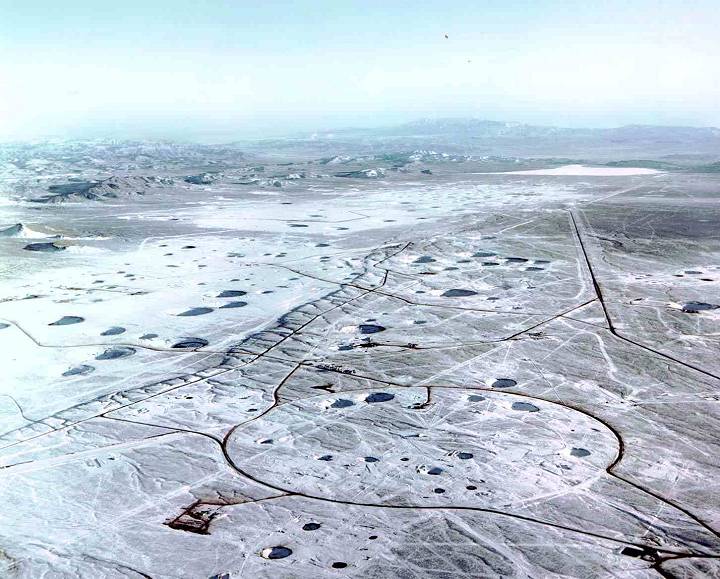
Yucca Flat (Yucca Valley), is where the majority of underground testing has been done. When you see a photo of the Nevada Test Site, it is generally of this area. It is filled with subsidence craters. These are a bit smoother, and more regular than the classic surface crater, created by a surface explosion. These craters are caused by having the ground collapse beneath them, as opposed to surface craters, which are formed by having the ground blown out and away. In an underground test, the explosion will create an underground chamber, primarily by melting and fusing the surrounding rock. When the pressure goes down, the chamber begins to collapse, under it's own weight. Eventually, that collapse makes it to the surface, though in a moderated and translated form. The size of the subsidence crater gives a rough indication of the original volume of the underground chamber.
This is the place where the majority of the nuclear tests took place. Yucca Flats is known for the cratered moonscape, produced by the hundreds of underground tests which occurred here; but there were also some atmospheric tests done here. The place is so well cratered that it resembles the surface of the moon, and astronauts were actually trained here, for moon landings and exploration. There were 86 above ground tests detonated on Yucca Flats, and we passed by several ground zeros, and saw the remnants of a number of tower anchors. We also had the opportunity to get up close, and personal with Bilby.
Bilby is a crater, created by a 249 kt underground test. Bilby is 1800 feet wide, and 80 feet deep. The device which created Bilby was set off 2400 feet underground. There is a road paved down into Bilby, and we took this road to the bottom of the crater, so that our guide could show us some of the monitoring gear, which is in place in all of the craters. Bilby is ideal for such a demonstration, because it's depth to width ration, of 1800 to 80, means that it slopes gradually enough, to be able to get a big tour bust down a paved road. So yes, we actually were driven down into the subsidence crater formed by an underground nuclear explosion.
Ice Cap is the most famous
underground test, that was ever not done. In 1992, the UK paid around 44 million
dollars, for use of the NTS, for an underground test they wished to stage. A
tower was built, a deep hole was drilled, and test instruments were built, and
installed in racks, to go down the hole. Finally, the materials for the nuclear
device were gathered, and assembled. Miles of special cabling, for the test
instruments was flaked out on the surface, to be ready for the lowering of the
test rack. Everything was in readiness. About two weeks before the test was
ready, America put a test moratorium in place. There was no refund. So the test
never did go off. However, it is an interesting thing to see. Everything is in
place, and it gives a pretty good picture of what it must have been like, just
before any of the many tests that were performed here. I suppose this is
revenge, for the war of 1812, or some such thing. Or perhaps it was just
carelessness, or plain old bad luck.
The DAF (Device Assembly Area), was designed for the assembly of nuclear devices, before detonation here, and was not visited by us. Note that this is called the device assembly area, not the bomb assembly area. Bombs have various safety and security devices, need to be armed, fused, and triggered. The nuclear devices destined for the NTS had no such complications. As such, they were the most dangerous devices in the world.
Because of
the inherent dangers, the 100,000 square foot DAF was designed to be the most secure
site in the country – more so than the White House, 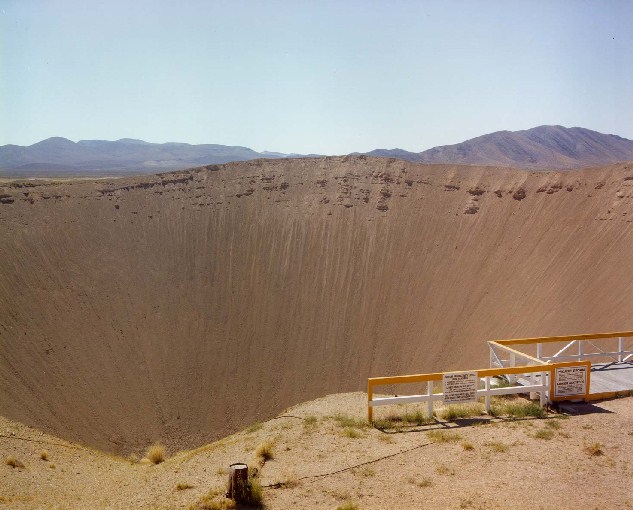
Our last stop on the tour, or at
least our furthest, was Sedan Crater.
The
Bilby and Sedan are both large and
impressive; but are made even more so, when their mode of creation is
considered. They are not human scale structures;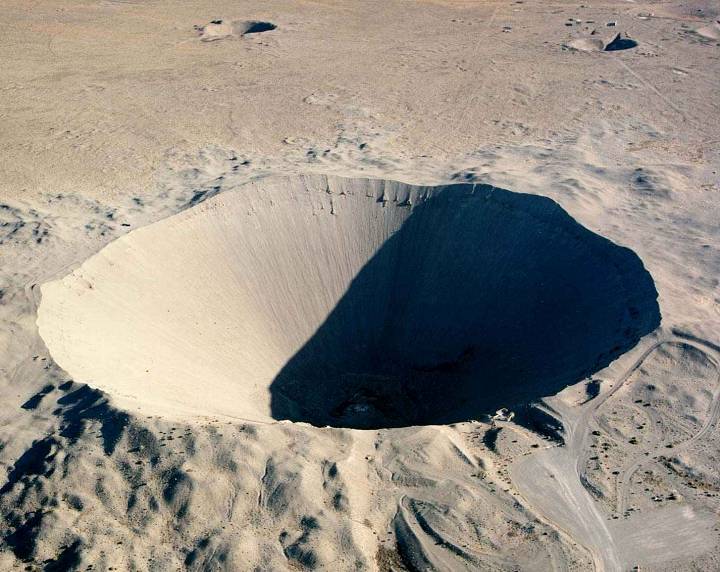 but are geologic scale structures. There are larger, and more impressive things
scattered about the Earth. I think of the Grand Canyon, Devil's Tower, and the
various volcanoes, mountains, and valleys which enrich the landscape; but Bilby
and Sedan are different. They are not geologic structures, made by tectonic
forces, volcanic forces, or the slow work of wind and water over the centuries.
These are man made artifacts, created in the space of a few seconds. The thought
is sobering, particularly considering that these are all rather small nuclear
explosions, when compared to many of the larger strategic weapons stockpiled.
but are geologic scale structures. There are larger, and more impressive things
scattered about the Earth. I think of the Grand Canyon, Devil's Tower, and the
various volcanoes, mountains, and valleys which enrich the landscape; but Bilby
and Sedan are different. They are not geologic structures, made by tectonic
forces, volcanic forces, or the slow work of wind and water over the centuries.
These are man made artifacts, created in the space of a few seconds. The thought
is sobering, particularly considering that these are all rather small nuclear
explosions, when compared to many of the larger strategic weapons stockpiled.
Most of the tests that were
performed here, had no presumption of peaceful application. The early tests were
to validate new weapons designs, and verify yields. The latter tests were to
ensure the continued viability of older weapons stockpiles. Weapons pits, or
cores are subject to nuclear decay, and the explosive lenses are subject to
degradation, particularly by heat. Most U.S. nuclear warheads have an expected
life of around thirty years, before they need to be tested for possible
recycling or retirement. If a representative sample of material from a stock piled
weapon type, can not be certified to work, then the whole type must be removed
from the active inventory. Many of the underground tests, during the Regan
administration, were of this type. Today, such validation is made through sub
critical testing, and computer modeling. It remains to be seen, how accurate
this type of testing may be. In the mean time, the site has standing orders to
remain in readiness, should testing ever resume.
 Staying
in readiness means keeping equipment stockpiled. There is a whole area of the
site, which we passed, filled with huge drill bits, derricks, gantries, and
other such drilling equipment. Though it never did get much press, one of the
great developments here was in the field of deep drilling. When the site was
started, it used off the shelf oil drilling technology, to drill the holes for
the underground shots. The problem, with this was that the maximum width of the
hole might be a foot or so. This might be sufficient for test holes, or
monitoring holes; but was hardly sufficient for the nuclear devices themselves,
or the racks full of instruments that went down the holes after them. New
technologies would need to be developed. At the end, the NTS was able to bore
holes up to 60" in diameter. The advances and unique gear which did this job, is
sitting out in the desert, in an area called the Drill Yard.
Staying
in readiness means keeping equipment stockpiled. There is a whole area of the
site, which we passed, filled with huge drill bits, derricks, gantries, and
other such drilling equipment. Though it never did get much press, one of the
great developments here was in the field of deep drilling. When the site was
started, it used off the shelf oil drilling technology, to drill the holes for
the underground shots. The problem, with this was that the maximum width of the
hole might be a foot or so. This might be sufficient for test holes, or
monitoring holes; but was hardly sufficient for the nuclear devices themselves,
or the racks full of instruments that went down the holes after them. New
technologies would need to be developed. At the end, the NTS was able to bore
holes up to 60" in diameter. The advances and unique gear which did this job, is
sitting out in the desert, in an area called the Drill Yard.
So there is the Drill yard, the DAF, long cables of specially designed testing wire, and the basic road power and infrastructure of the site, which would save quite a bit of time, were the site ever called upon to resume it's primary function. All of the tests were set off from Control Point 1, which sits at a central location of the site, and bristles with antenna. Control Point 1 is still staffed, somewhat, and still operational, mostly to do sub critical tests; but the site is not what it once was. Were testing to resume, it is estimated that it would take two years to hire, train, and deploy the people, and rebuild some of the resources of the site which have been dismantled, or allowed to fall into disrepair.
Much of what was built, and then destroyed here, has been left in place. A bus ride, through the area, and around the structures, is a sort of a trip to the post apocalyptic world of Mad Max, or a sort of a nuclear ghost town. There are piles of rubble, steel shelters squashed flat, like pancakes, and reinforced concrete shelters smashed like so many eggs dropped form a giant's grocery basket. There was a bank vault, with the sides partially abraded away, and the vault door singed, though intact. Our guide advised us that the test money left in the vault, survived, and was removed. We passed railroad bridges, with girders twisted, and curved as if they were To say that they were bent, does not do justice to the extent that they were twisted, nor to the frighteningly consistency of the deformity. I would not have wanted to have been here, fifty odd years ago, when these tests were conducted, and yet, the area was not without inhabitants.
Pens full of pigs were set up at various distances from ground zero. Some of the pigs were dressed in military uniforms, to gauge the amount of protection that various materials, and styles of uniform might provide. Further off, men were crouched in slit trenches, waiting for the order to advance towards ground zero, after the explosion had subsided. This was pretty cruel, as these animals were doomed to be burned alive, at various distances, and to various degrees, so that the extent of their wounds could be gauged. Soldiers and scientists are not without feelings. They referred to the pens as the Porker Hilton, trying to inject some levity, and tried not to think about what was to happen there. I saw the pens, from the bus window; they were blackened, and quite badly charred. Many humans also fared rather badly, from exposure during the tests, though not as badly as most of the pigs.
A number of soldiers, and others associated with the early nuclear tests, suffered complications, thought to be related to exposure to radiation, or nuclear contamination. There were also issues with certain areas downwind of the NTS, particularly in Utah. The most famous casualty of these tests was John Wayne, who spent some months here filming what is arguably one of the worst movies ever made. In 1954, a year after a series of 11 test had been conducted at the site, 220 members of the cast and film crew of the movie The Conqueror, spent three months filming in Snow Valley Utah, 137 miles from NTS. It turns out that the geography of the valley channeled and concentrated the already dangerous amount of fallout carried from the site, into a hot spot. Of the 220 people, 91 developed cancer, including the children of stars John Wayne, and Susan Hayward, who accompanied their parents. The nearby town of St. George was afflicted with higher than normal cancer rates, as were a number of other settlements in the path of the prevailing winds from the site.
We were shown a number of videos, on the bus to and from the site. Portions of these videos addressed the issue of collateral damage, and exposure of citizens and workers, to radiation, and contamination by fallout. Officials were very regretful, and admit that there were things that were not known in the early days, and that certain procedures were not as safe as they could have been. Whatever regret they may have felt about things that happened, they were not apologetic. This was the Cold war, after all, and though there was no overt fighting between the two superpowers, this does not mean that battles were not fought. The major battles of the Cold War were fought at places like Sandia Laboratories, the White Sands Missile Range, and the Nevada Test Site. Korea, Viet Nam, Cuba, Hungary, and the hot parts of the Cold War were mere skirmishes. The war was won by what happened at the labs, armories, and testing grounds right on the North American continent. With this in mind, those who were affected by what happened at NTS were to be considered as casualties of war, the same is if they were injured by enemy bombs, or bullets. At any rate, this is the official line. It is actually a pretty valid argument. Had we not developed, tested and put into place a viable, and credible defense, there may very well have been bombs, missiles, and a hot war going on, including attacks upon the United States homeland.
I have never seen a nuclear explosion, other than in movies, and photos; but I am pretty certain of one thing. Even though I am quite pro nuclear, I suspect that I would be quite scared. Who in their right mind wouldn't be? These are weapons of fearsome power, with long lasting after effects. After over fifty years, some of the test sites in the Pacific are still too hot for human occupancy. The cost of winning the Cold War was high; but then, war is never cheap.
Overachiever
(Found on the web)
"Every kid who has put a firecracker under a tin can
understands the principle of using high explosives to loft an object into space.
What was novel to scientists at
"Project Thunderwell was the inspiration of astrophysicist Bob Brownlee, who in
the summer of 1957 was faced with the problem of containing underground an
explosion, expected to be equivalent to a few hundred tons of dynamite. Brownlee
put the bomb at the bottom of a 500-foot vertical tunnel in the
"The following October the
The Atomic Testing Museum
The Atomic Testing Museum is affiliated with the Smithsonian, and has a working relationship with the Nevada Test Site. It is located somewhat off of the strip, and not too far from the airport, in Las Vegas. This is where the tour groups meet, for the monthly trips out to the Nevada Test Site. If you are in Las Vegas, I recommend a visit, with certain reservations. I consider the National Atomic Museum, in Albuquerque, to be far batter. In part because the testing museum committed what is a nearly unforgivable sin, in my eyes. They forbid photography within the museum. While the Nevada Test Site is a government reservation, with some secret tests still going on, the museum is, a museum. How can you charge admission to a tourist attraction, and then refuse to allow people to take photos?
Oh well, whining aside, there are some interesting things to see at the museum. It mostly seems to be a repository of films, videos, and photos, including the old propaganda and civil defense shorts of the fifties and sixties. With the Cold war over, these can seem pretty funny, though they weren't so amusing back when they were made. There are also a number of videos of various atomic tests. The crown jewel of the place is it's bunker/theater, which attempts to reenact a nuclear test. The museum is a nice compliment to a visit to NTS; but I wouldn't go too far out of my way for a visit. There are various exhibits dealing with Cold War culture, the science of testing, and of nuclear weapons, and the newly developed drilling and tunneling techniques which underground testing requires. There are museum guides who are knowledgeable, and enthusiastic about the subject. Both guides who were working the site during my visit, had worked at the test site.